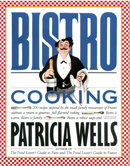Books |
Bistro Cooking
Patricia Wells
By
Published: Oct 31, 2021
Category:
Food and Wine
Last week I went to a friend’s home for dinner, my first dining experience in a private space in 18 months. The pre-dinner chat was delightful; all four of us have strong views, and it was joy to rag on movies and books we loathed with no danger of the people at the next table hearing every incriminating word. Our host popped up to check on dinner, which focused us on the fact we were actually going to sit a table that wasn’t on a sidewalk. What was she serving? She was coy: “It’s from a cookbook you know.” I guessed Marcella Hazan’s Essentials of Classic Italian Cooking. Another guest suggested an equal classic, Julia Child and Simone Beck’s Mastering The Art of French Cooking. Maybe the pandemic had led us away from animal entrees. Perhaps V Is for Vegetables: Inspired Recipes & Techniques for Home Cooks — from Artichokes to Zucchini. Or maybe an American classic, Canal House Cooks Every Day.
Our host was a Sphinx. At the table, she asked us to guess what we were eating. I was understandably clueless — it was skate, with Savoy cabbage, in a sauce so delicate it was almost broth. The source of the recipe: this book, her favorite since forever. I smiled. I once had a dinner cooked by James Salter, a food snob and the co-author of a book about food only a great prose stylist could write. The recipe came from this book.
Patricia Wells, bless her, focused on bistros long before they were chic. But then, she is one of the world’s most sensible food writers; she reports on trends, but doesn’t succumb to them. The French noticed her talent long ago — she’s the only woman (and the only foreigner) ever to review restaurants for a French publication.
“Bistro Cooking,” published in 1989, was named Cookbook of the Year by USA Today. Good choice. The recipes are straightforward, the ingredients basic, the instructions clear. She’s strong on vegetables and salads. There are half a dozen chicken entrees that can be prepared in a matter of minutes. (To buy “Bistro Cooking” from Amazon, click here. For the Kindle edition, click here. To read about another excellent Patricia Wells cookbook, “Trattoria: Simple and Robust Fare Inspired by the Small Family Restaurants of Italy,” click here.)
What recipe to choose? One of many one-dish meals that are idiot-proof. It’s certainly “simple” and “satisfying” — I have served this for many Sunday lunches, and it has always required shockingly modest effort and garnered outrageous praise. The trick: The pan is lined with sliced potatoes, onions and tomatoes. The lamb is set on a rack over the vegetables. The result? As it roasts, “the lamb’s wonderful juices drip into the gratin.” Wells suggests that you serve this with a “solid” red wine: a Cotes-du-Rhone or Chateauneuf-du-Pape, but any Bordeaux or California Cabernet would be just as good.
GIGOT ROTI AU GRATIN DE MONSIEUR HENRY
(Roast Lamb with Monsieur Henry’s Potato, Onion and Tomato Gratin)
serves 8-10
6 garlic cloves (1 clove peeled and split, the rest peeled and chopped)
1 pounds baking potatoes, peeled and sliced very thin
2 large onions, peeled and sliced very thin
5 medium tomatoes, cored and sliced very thin
1 leg of lamb, bone-in (6-7 pounds)
2/3 cup white wine
1/3 cup extra virgin olive oil
l tablespoon fresh thyme salt, pepper
Preheat oven to 400 degrees.
Rub the bottom of a large (16 x 10 x 2) oval porcelain gratin dish (or casserole dish) with the split clove of garlic.
Arrange the potatoes in a single layer, season with salt, pepper, some of the thyme and some of the chopped garlic.
Layer the sliced onions on top, season as you did the potatoes.
Layer the tomatoes on top of the onions. Season with salt, pepper, the rest of the thyme and chopped garlic.
Pour on the white wine, then the olive oil.
Trim the thicker portions of fat from the lamb, season with salt and pepper. Set a cake or oven rack on (or in) the gratin dish and set the lamb on the rack so its juices will drip into the gratin.
Roast, uncovered, for 1 hour and 15 minutes for rare lamb (for medium lamb, roast for 15-30 more minutes). Turn the lamb every 15 minutes, basting with liquid from the gratin dish.
Remove the pan from oven and let the lamb sit for 15 minutes before carving.
Serve the thinly sliced lamb on warmed dinner plates, with the gratin alongside. Vegetable suggestion: Green or French beans.


